What the ... ?
I stopped and spent a night in Georgia on my drive back from Louisiana a couple of weeks ago. As I become more mature (ahem, older), I become less and less excited about a 12-hour or overnight drive. I figure the road and the drive will still be there when I get up the next morning, so what’s the hurry?
I found a few azalea bushes under the light posts in the hotel parking lot. Tell you what, these azaleas weren’t too happy. They were thin and chlorotic. Something was wrong.
What was wrong?
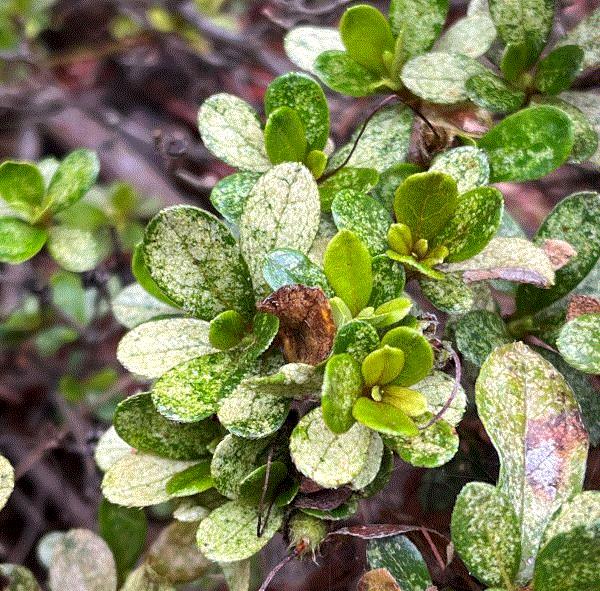
Stick 'em With Yellow or Blue?
This month, Leanne Pundt, Carla Caballero and Rosa Raudales of the University of Connecticut published a wonderful e-GRO Alert article on using yellow sticky cards in greenhouses. Leanne, Carla and Rosa discussed what yellow sticky cards are good for (easy scouting tool), not so good for (scouting for insects and mites that don’t fly) and how to use them (three to four cards per 1,000 sq. ft. and change weekly). The article is a good review of the use of yellow sticky cards, and has lots of useful information and great pictures. It also has links to videos, in English or Spanish, on how to properly use and identify insects caught on sticky cards. Click HERE for the e-GRO Alert.
One topic Leanne, Carla and Rosa didn’t address in the article is the question of yellow vs. blue sticky cards. I get this question almost every time I talk about scouting and sticky cards, no matter where I am in the country. I’ll take this opportunity to address this question.
The typical recommendation is to use blue cards for thrips and yellow cards for everything else. There's quite a bit of data, from both indoor and outdoor crop systems, to support this recommendation. For me, I tend to use yellow sticky cards because I can capture more insect species with one card. Thrips are also attracted to yellow sticky cards, albeit they're a little harder to see on a yellow background. This inconvenience isn’t enough to dissuade me from using only yellow sticky cards. I don’t have to think about keeping stocks of different colors at all times. Red cards for fungus gnats, anyone?
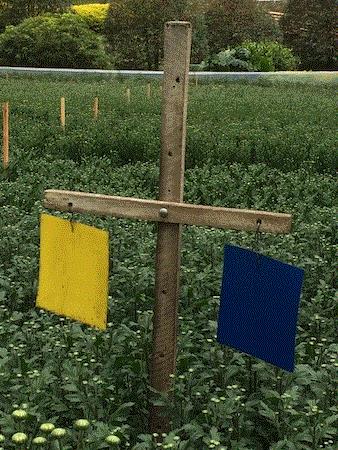
By the way, you can pair the sticky cards with a lure (such as Thrips-Lure or Thripline) to increase the capture of thrips. You may find other lures for thrips or other insects online, but not all of them are available in the United States or Canada.
I heard from some folks that the reason they don’t want to use yellow or blue sticky cards is because they don’t want to capture their biological control agents, particularly the parasitic wasps they release. I can understand that—these wasps aren’t cheap and they can better serve their purpose on the plants, not on the sticky cards.
The data I've seen isn’t particularly conclusive on which color attracts more biological control agents. Many seem to suggest more by-catch of parasitic wasps on blue cards and predatory insects on yellow cards. Sure, you can choose which color to put out depending on your biological control agent. Or—like Leanne, Carla and Rosa said in the article—remove the sticky cards for a few days after release so that you don’t capture the biological control agents by mistake.
After all this jabbering, ultimately, I only care if y’all use sticky cards or not. If you don’t want to guess, then use yellow sticky cards. Sticky cards are so cheap and easy to use, and they give us so much information about the presence, identity and abundance of insect pests. Why don’t we use them more often? There’s really no excuse. The next time I walk into your operation, I hope I see sticky cards.

A New Multi-virus Test Kit
Agdia has added a new virus test strip to its extensive offering of diagnostic tools and tests. Called the Thrips Spot Viruses ImmunoCombo, this new test kit combines all immunostrips used to detect and confirm three viruses in a single, easy-to-use kit.
The target viruses are impatiens necrotic spot virus (INSV), tobacco streak virus (TSV) and tomato spotted wilt virus (TSWV), which are the most common thrips-transmitted viruses we find on greenhouse-grown ornamental plants, herbs and vegetables. These viruses cause similar symptoms, so scouts and diagnosticians often have to test for all three viruses at the same time.
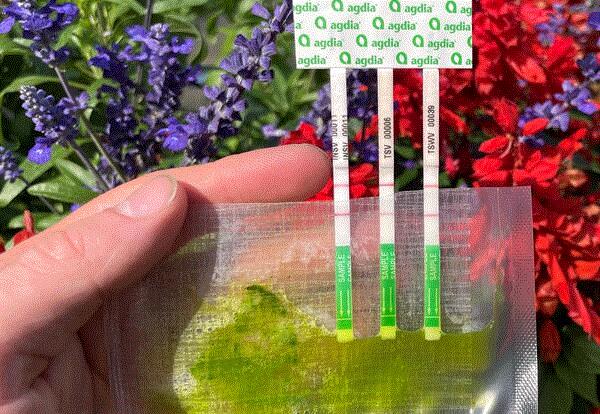
Instead of testing for these viruses with individual immunostrips, you can now test for all of them at the same time using a single kit. The way to use this new test kit is the same as an individual strip—put the leaves (symptomatic or asymptomatic) in the buffer-filled extraction bag that comes with the kit, macerate the leaves and dip the test stripes in the solution. Wait for a few minutes and voilà! You know whether you have viruses and which one it is. Best of all, you can use the test kit in the field and get identification within minutes.
Click HERE for more information on the new test strip for multiple thrips-transmitted viruses.

Another Murder Hornet? Gasp!
The Georgia Department of Agriculture (GDA), which will never get on the list of rabble-rousers, stunned the world with its announcement of the detection of the yellow-legged hornet in the Peach State earlier this month. The yellow-legged hornet is a first cousin of the famed Asian giant hornet or (officially) the northern giant hornet; the latter is also known popularly as the “murder hornet.”
A hornet collected by a beekeeper in Savannah, Georgia, was identified as the yellow-legged hornet, a species native to Southeast Asia. The identification was confirmed by experts at the University of Georgia and USDA-APHIS. This represents the first report of this species in the United States. This species has already been reported in East Asia, the Middle East and most of Europe.
Similar to its more famous cousin, the yellow-legged hornet also attacks and feeds on honeybees and other pollinators, so this new invasive hornet can pose a threat to bee keeping. For humans, it may not be such a big deal because it’s reported to be non-aggressive to humans and only attacks when threatened, according to a medical paper published in 2020.
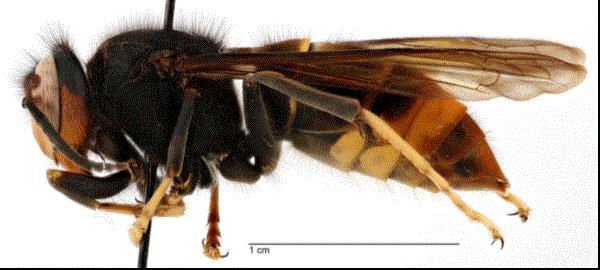
Although the yellow-legged hornet has only been reported in Georgia so far, there are reports of folks seeing or being stung by this hornet species in Illinois, Oregon and South Carolina, among other places, and posted in the comment section of every news outlet carrying this news. Once again, the Facebook crowd is way ahead of any governmental agency or university. The newest murder hornet is invading your neighborhood—do you know where your children (or grandchildren) are?
I’m sorry for being so snarky. I just can’t help my true self. There are lots of hornet look-alikes out there; even I cannot tell one species from another. So calm down, folks. If you find a hornet and ain’t sure if it’s the yellow-legged hornet, collect and send the bug to experts at state departments of agriculture or USDA-APHIS for identification before you post on your favorite social media.

Invasive Species Tour
Georgia isn’t famous for being the gateway to invasive species. Florida has that honor. (Or notoriety?) I worked with biological control of invasive species in Florida when I was a post-doctoral researcher. The work continues, simply because there are so many new ones every year!
Sign up for the 2023 Invasive Species Tour if you work with invasive species, are in Extension Service, or if you’re interested in learning more about invasive pests and diseases, such as laurel wilt, citrus greening, lebbeck mealybug, invasive snails and more. The tour is organized by David Coyle of Clemson University and Lauren Diepenbrock of the University of Florida, and hosted by the Entomological Society of America.
The tour will start with everyone’s arrival on September 12 in Orlando. Participants will visit several locations and research facilities in central Florida where invasive species can be seen in action during the two days.
Sign up for the tour and find an agenda of the tour by going HERE.

Answer to “What the … ?”
Azalea doesn’t have many pests. The most serious pest, the azalea lacebug, is the culprit that causes the stippling or discoloration on the sad-looking azalea bushes I saw outside of a hotel in Georgia. Azalea lacebug is native to Japan; it’s now distributed throughout much of the eastern United States. This lacebug species only feeds on azaleas, whwere damage seems particularly severe on evergreen azaleas.
I have plenty of azaleas around my house, but I never have to do anything with them. They grow and grow until my wife says I must trim them back and kick out the racoons that have made a den under the bushes. Usually, they grow some more before I’ll do any pruning and find a dog toy or two underneath. I’m happy to report that I've never had any azalea lacebug problems on these azaleas because they're grown under the shade.
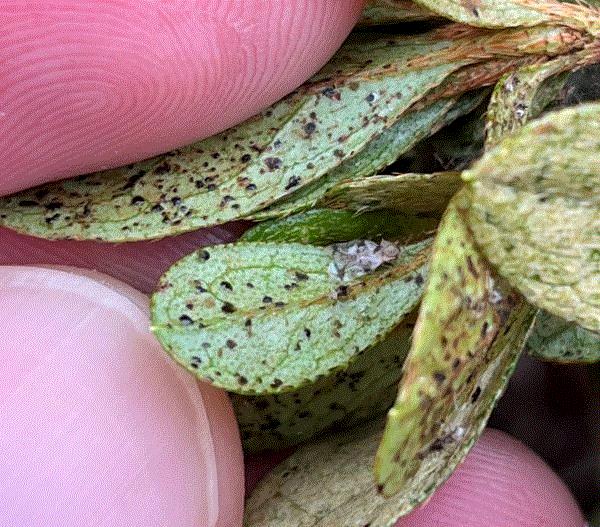
That points to the importance of growing azaleas in the right place to avoid some problems. Can you grow azaleas under full sun? Why, of course you can! You can also flop yourself down on a beach without any sun protection, thinking that you’ll be able to tan your winter-pale skin faster, but that doesn’t mean it’s a good idea. Azalea prefers partial shade or filtered light, particularly in the afternoon. If you plant them under full sun, like those bushes I saw in the hotel parking lot, they’re going to be stressed and become more susceptible to bugs and diseases.
Also, bugs grow faster and bigger where the temperature is higher, such as near pavement or a parking lot (as with many insect and mite pests under urban heat island effect). And it’s hypothesized that there are more natural enemies of azalea lacebugs in the shade. These azalea bushes I saw were clearly in the wrong spot.
I think the azalea lacebug is good looking. Adults are flattened, almost transparent, with a netted lacy thorax and wings. (The latter characteristic is shared by all lacebug species, which gives this family its common name.) Females lay eggs on the underside of leaves and cover the eggs with black tar-like fecal droplets for protection. Nymphs are black and spiny. You’ll often find all life stages on the underside of leaves. I can find two to three generations per year in South Carolina. Click HERE for more information about the azalea lacebug.
Azalea lacebug has piercing-sucking mouthparts, but different from aphids and whiteflies, which suck from the phloem or xylem. Azalea lacebugs suck from individual leaf cells, remove cell contents and leave behind stippling. The bush can look bleached if the lacebug population is large and the stippling damage is severe. Also, azalea lacebug doesn’t produce honeydew and sooty mold because it doesn’t have excess phloem or xylem sap to process.
Infested azalea bushes, or those grown under full sun, may need to be protected with insecticides. Systemic insecticides, particularly neonicotinoids, are effective when applied as a drench in the spring. Usually, one drench application is sufficient to prevent severe damage for the year. If additional treatment is needed, foliar spray of pyrethroids, organophosphates, neonicotinoids, diamides, azadirachtin, horticultural oil and insecticidal soap can be applied when nymphs and adults are present.
Click HERE to see a previous issue of this newsletter about the efficacy of insect growth regulators (including azadirachtin) against azalea lacebugs. I don’t usually recommend using pyrethroids, organophosphates and neonicotinoids because of their negative impact on the natural enemies of azalea lacebugs.
Remember that the stippling is permanent. The purpose of the insecticide treatment is to protect the new growth. Check the old and new leaves after treatment and see if the lacebug population has been reduced, then decide if additional treatment is needed.



See y’all later!

JC Chong
Technical Development Manager at SePRO
Adjunct Professor at Clemson University
This e-mail received by 27,847 subscribers like you!
If you're interested in advertising on PestTalks contact Kim Brown ASAP!